Type D influenza virus fluorescent quantitative PCR primer pair and kit
A technology for influenza virus and fluorescence quantification, applied in the field of bioengineering, can solve the problems of unfavorable application and high cost of synthetic probes, and achieve high sensitivity, simple and fast detection method, and good repeatability
- Summary
- Abstract
- Description
- Claims
- Application Information
AI Technical Summary
Problems solved by technology
Method used
Image
Examples
Embodiment 1
[0014] Example 1, routine PCR amplification of the target fragment of IDV genome.
[0015] Dissolve 4 μg of artificially synthesized template plasmid dry powder in 80 μL H2O. The PCR reaction system is: 12.5 μL of Primix ExTaqTM enzyme, 1 μL of upstream and downstream primers (10 μmol / L), 2 μL of DNA template (template plasmid), plus sterilized three-distilled water to a total volume of 25 μL. After the above components were mixed and centrifuged briefly, the following procedures were performed on the temperature gradient PCR instrument: pre-denaturation at 94°C for 4 minutes; denaturation at 94°C for 30 seconds, annealing at 55°C for 30 seconds, extension at 72°C for 30 seconds; 34 cycles, and finally extension at 72°C 10min. Take 6 μL of the reaction product for 1% agarose gel electrophoresis, the results are as follows: figure 1 shown.
Embodiment 2
[0016] Example 2, preparation of positive IDV plasmid.
[0017] After electrophoresis of the PCR target product, use TaKaRa MiniBEST Agarose Gel DNA Extraction KitVer.4.0 to perform gel recovery according to the instructions. Using the pMD18-T Vector Ligation Kit from TaKaRa Company, the total volume of the reaction system was 5 μL as follows: 2.25 μL of PCR purified product, 2.5 μL of Ligation Solution I, 0.25 μL of pMD18-T Vector, operated on ice, and reacted at 16°C for 4 hours. Transformation of recombinant plasmids, colony PCR identification, sequence analysis, and a small amount of positive bacterial liquid was extracted and purified according to TaKaRaMiniBEST Plasmid Purification Kit Ver.4.0, and stored at -20°C for future use.
Embodiment 3
[0018] Example 3, optimization of real-time fluorescent quantitative PCR reaction conditions.
[0019] 3.1 Optimization of annealing temperature: Real-time fluorescent quantitative PCR amplification was carried out with the positive plasmid as a template, the optimal annealing temperature was screened, and 7 temperature gradients were set, 54.0°C, 54.3°C, 55.0°C, 56.0°C, 57.2°C, 58.2°C, 58.7°C. The reaction system is 25 μL, and the reaction procedure is shown in Table 1:
[0020] Table 1 Reaction program
[0021]
[0022] With any copy number of positive plasmids, seven different annealing temperature gradients were used for real-time fluorescent quantitative PCR detection, and the results showed that the annealing temperature was the best at 55°C.
[0023] 3.2 Optimization of primer concentration: according to the optimal annealing temperature determined above, real-time fluorescent quantitative PCR amplification was carried out using the positive plasmid as a template, ...
PUM
| Property | Measurement | Unit |
|---|---|---|
| correlation coefficient | aaaaa | aaaaa |
| PCR efficiency | aaaaa | aaaaa |
Abstract
Description
Claims
Application Information
 Login to View More
Login to View More - R&D
- Intellectual Property
- Life Sciences
- Materials
- Tech Scout
- Unparalleled Data Quality
- Higher Quality Content
- 60% Fewer Hallucinations
Browse by: Latest US Patents, China's latest patents, Technical Efficacy Thesaurus, Application Domain, Technology Topic, Popular Technical Reports.
© 2025 PatSnap. All rights reserved.Legal|Privacy policy|Modern Slavery Act Transparency Statement|Sitemap|About US| Contact US: help@patsnap.com



